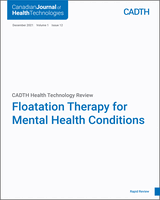|
Feinstein et al. (2018)
9
US
Funding: William K. Warren Foundation, Epsom Salt Council, and National Institute of Health Centres of Biomedical Research Excellence
| Open-label RCT, within-subject crossover design Sample size calculation provided: No ITT: Yes | Adults with high levels of anxiety sensitivity (N = 31) Mean age, years (SD): 39.1 (11.1) % Male: 38.7 Comorbidities: Condition on medication stable for 6 weeks or longer (n = 21)Mean anxiety sensitivity, measured with ASI-3a (SD): 28.1 (12.3) Mean anxiety severity, measured with OASISb (SD): 10.0 (3.8) Mean depression severity, measured with PHQ-9c (SD): 11.6 (5.5) Mean level of disability, measured with SDSd (SD): 14.7 (8.0) | Floatation-REST (float condition) (N = 15) Exteroceptive comparator (film condition)e (N = 16) Participants completed a 90-minute session of Floatation-REST or exteroceptive comparator. After completion of 1 condition, participants crossed over to the other condition approximately 1 week later. Both conditions were scheduled to occur at the same time of day for each participant. | Outcomes:Safety and tolerability State anxiety (measured with STAIf) Relaxation (measured with VASg) Muscle tension (measured with VASh) Serenity (measured with PANAS-Xi) Blood pressure Interoceptive measures
Follow-up: None other than immediately after 90 minutes of treatment |
|
Jonsson and Kjellgren (2016)
10
Sweden
Funding: Unrestricted grant from the County Council of Värmland, Sweden
| Open-label RCT, parallel-group design Sample size calculation provided: Yes ITT: No | Adults with GAD (N = 50) Mean age, years (SD): 43.04 (13.37) % Male: 30 % Participants stable on medication: 40 % Participants having psychotherapy: 34 Mean pathological worry, measured with PSWQk (SD): 60.00 (10.84) Mean GAD-symptomatology, measured with GAD-Q-IVl (SD): 9.87 (2.19) Mean depression, measured with MADRS-Sj (SD): 22.48 (7.51) Mean sleep difficulties, measured with PSQIm (SD): 10.17 (3.70) Mean difficulties in emotion regulation, measured with DERSn (SD): 99.74 (20.13) Mean mindfulness, measured with MAASo (SD): 3.29 (0.78) | Floatation-REST (N = 25) Waitlist (N = 25) Floatation-REST consisted of 12 sessions (45 minutes each) extending over 7 weeks with 2 sessions per week. | Outcomes:Depression (measured with MADRS-Sj) Pathological worry (measured with PSWQk) GAD-symptomatology (measured with GAD-Q-IVl) Sleep difficulties (measured with PSQIm) Difficulties in emotion regulation (measured with DERSn) Mindfulness (measured with MAASo) Experienced deviations from normal state (measured with EDNp)
Follow-up: 6 months after the end of treatment |
